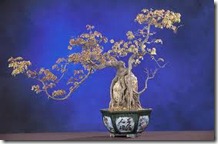 Wiring is a method of bending trunks and branches using wires in order to
Wiring is a method of bending trunks and branches using wires in order to
achieve various impressive shapes. When the plant is still very young, the
trunk is bent into the basic shape of a tree. Later on, as the plant grows, you
bend the first branch (ichi-no-eda), the second branch (ni-no-eda), the third
branch (san-no-eda), and so on until the final branch that determines the
shape of the bonsai plant. If you cannot achieve the ideal shape with one
wiring, you can do so in stages. By the time you complete the bonsai tree’s
final shape, you can finesse the details of the small branches with wires.
Why Do We Wire?
We wire because it allows us, the bonsai enthusiast, to train, to shape, to
style, and ultimately, to create bonsai. Bonsai is a living art form. It is a
collaboration between nature and us. Nature provides the inspiration and we
must provide the imagination. Wire provides us with our artistic license. That
license gives us the freedom to place a branch where our imagination tells us
one is needed. It allows us to give movement to the motionless. It provides
us with the ability to supply stability where stability is required. Wire is an
essential tool of the bonsai artist and wiring is an essential skill of the bonsai
artist. So, it behooves anyone serious about bonsai to become proficient at
and familiar with wire and wiring.
Types Of Wire?
There are two types or kinds of wire used in bonsai: copper and aluminum.
Copper wire is stronger, but in my experience, is less forgiving. If it is not
monitored very closely, it will invariably bite into your bonsai, scaring bark and
branches alike. Aluminum wire, on the other hand, has one-quarter the
strength of copper wire, but it is easier to apply and easier to remove. These
two fundamental characteristics make aluminum wire an advantage for the
beginner and a blessing for the experienced.
How Should You Wire?
The rule of thumb for selecting the proper gauge wire is to use a wire that is
roughly 1/3 the width of the section of your bonsai that you are planning to
wire. Apply the wire at a 45-degree angle; making certain that it is wrapped
neither too tight, nor too loose. Bending the trunk or branch, should be done
using both hands. It is important to support the trunk or branch, as much as
possible, as you proceed. Be sure to hold the wire from behind with your
thumb, as you proceed forward, bend the wire and not the trunk or branch.
If you are wiring the entire bonsai, it is best to begin with the trunk and then
move on to the largest branch and then to the next largest branch and so
on…. Also, it is imperative that you wire in the direction of yourself. It is
easier and safer, because you will be able to avoid wiring over any buds,
leaves or twigs that may be hidden by your arms or hands; and on a
pragmatic level, you will be able to cut off the excess wire as you reach the
very end of the branch.
When Should You Wire?
You should always secure a bonsai that has just been repotted with a wire
running up from the bottom of the pot through the drainage holes.
In regards to what season is optimal to wire your bonsai for styling
purposes, the answer is: it depends upon what type of bonsai you’re styling.
If you grow pines, it is often recommended that you wire in the late fall or
early winter, when sap levels are low and trees are more flexible. If you grow
deciduous trees, then early spring – before your bonsai leafs out – is a good
choice, as a leafless tree allows you to see the entire branch structure clearly.
As for when to remove the wire from your bonsai, the safest answer is:
before it bites into the bark of the tree. If you are using copper wire, checking
weekly is prudent. If you are using aluminum wire, checking bi-weekly is
advisable. You should only remove wire with the use of wire cutters. Trying to
unwind a wire usually results in a crack or split, which is followed immediately
by inconsolable weeping.
Wire & Wiring Concerns:
Only wire a healthy bonsai. The wiring process stresses your bonsai and if it
is already weak, you may be hastening its journey to the pearly gates. Also, it
is a good idea to allow your bonsai to dry out for a couple of days before
wiring, because a slightly dehydrated bonsai is more flexible and less likely to
split or crack while being wired.

Deprecated: strpos(): Passing null to parameter #1 ($haystack) of type string is deprecated in /home/agriviek8Qv/agriviet.net/public_html/wp-includes/comment-template.php on line 2522